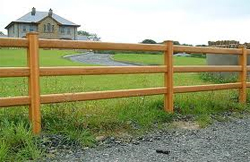Post & rail fencing gets its name from the way it is styled. To make this type of fence, perpendicular posts are put into the ground. A minimum of two horizontal rails are affixed between each set of posts. Post & rail fencing is known for its rustic look and is popular for use on pastures and horse farms. Usually, this type of fencing is constructed from wood; however, there are some manufactures that produce synthetic post & rail fencing. This fencing is usually made with square or round posts and flat or round nails.

Installing Post & Rail Fences
When it comes to installing post & rail fencing, you can either use one of two methods:
* The Mortise Method
* The Nail/Screw Method.
In order to reinforce the fence, many owners use the mortise method. Mortises are simply holes that are cut into each post. The rails slide through these holes. The nail/screw method is much cheaper; however, it makes the fence less durable. Using the nail/screw method, the fence boards are just screwed or nailed onto the posts. This method also takes less time. Even though the mortise method makes for a more durable fencing structure, it is costly and time consuming.
Either square or round posts will be suitable if you decide to attach the rails with the mortise method. The holes should be bored in the wood at specific height intervals predetermined by you. Usually, the rails need to be cut slightly more narrow at each end. Then, the rails can be put into each hole in the post. The rails will simply sit in the holes; therefore, they will not require any more work to attach them.
However, if you decide to use the nail/screw method, the process will work much differently. For this method, you must use square posts. In order to construct post & rail fencing, you need to dig a line of holes for the posts. It is best to set the holes approximately six feet apart. Use 12-foot long rails and nail them to every alternate post on the fence line.
Post & Rail Fence Materials
The open design of post & rail fencing makes it ideal for containing large animals and marking property lines. On the other hand, the design does nothing to provide privacy or block the wind and sun. When it comes to the materials used for post & rail fencing, there are many options. Some of the most common material choices in terms of wood include:
* Painted Wood
* Stained Wood
* Natural Wood
* Pressure-Treated Wood
* Rot-Resistant Wood.
If you prefer to use a synthetic material, vinyl is a popular alternative that can be pressed to mimic a wood pattern.
Split-Rail Fencing
Split-rail is a type of post & rail fencing that utilizes narrow logs. These logs are split lengthwise in order to make rails. Like traditional post & rail fences, split-rail fences have a rustic look because the rails follow the logs' natural lines.
